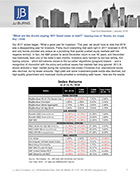We hope you have been enjoying the fall season thus far. As we head into the final stretch of 2024, we wanted to offer an overview of key developments that occurred in the third quarter.
S&P 500: Four Straight Positive Quarters
It’s four positive quarters in a row for the broadest measure of the U.S. economy, the S&P 500, with a remarkable seven out of the last eight quarters in the green. Long-term investors have been rewarded (and perhaps spoiled a little bit, dare I say!) for the last year or two.
Regardless of the headlines that have come our way for the last eight quarters (think inflation, high interest rates, government shutdowns, etc.), the broader equity indexes continued to climb.
For the third quarter of 2024, the S&P 500 increased by 5.53%, the Nasdaq 100 rose 1.92%, and the Dow Jones Industrial Average jumped by 8.21%, as industrials outperformed.
Broad Economy
Expectations for lower rates combined with declining inflation remain front and center. The Fed highlighted a “recalibration” message at the last policy meeting, tying the rate cut to a need to stimulate the labor markets as opposed to being a response to a struggling economy.
A 50-basis-point cut is in the books, and the number one question on the minds of the investment community is…
Soft, Hard, or No Landing?
The rate hike cycle appears to be over, and the Fed’s intended consequences of quelling inflation have seemingly come to fruition in the form of a slowing labor market. Simultaneously, we have seen inflation drop over the last three months, according to multiple metrics.
Now, the Fed is looking to thread the needle by adding some steam into the labor market, but not too much and not too little—essentially creating a Goldilocks scenario of “just right.”
A recession remains a possibility. But there aren’t too many talking about a recession to start the third quarter, as the fresh rate cut creates loosened-up lending markets and provides a dose of stimulus into the economy.
With that said, it’s October and an election year, so anything is possible.
Inflation Softer for Third Quarter
Consumer Price Index: June consumer pricing, released in July, actually fell on a monthly basis, with data showing a 0.1% monthly decrease from May, two ticks lower than the Dow Jones estimate for a 0.1% monthly increase.
July consumer price Index data showed continued cooling for the month, with the annual inflation rate slowing to 2.9%. The interest rate cut case became more likely.
Finally, August Consumer Price Index data revealed a 0.2% increase in monthly CPI, resulting in an annual increase of 2.5%—the lowest annual inflation rate since 2021 and a 0.4% decline from the previous month. These data releases helped cement the inflation-cooling theme as markets waited on the September Fed meeting, which resulted in a 50-basis-point cut.
August Volatility Spike
While the quarter was positive yet again, it wasn’t without some volatility early in the quarter—and what a volatility spike that was. Even more to marvel at was the speed of its dissipation.
The Japanese Yen carry trade wreaked some havoc on world financial markets in early August. The effects were felt worldwide but were short-lived.
After spiking above $60, the S&P 500 Volatility Index ($VIX) settled the first week of August’s trading near $20.37. This volatility spike will go down in history books.
Labor Market Concerns
As mentioned, labor market concerns popped up in a big way in the third quarter. There were substantial revisions to previously reported labor market data to the tune of 818,000 jobs revised downward over the preceding 12-month period.
Looking at the three nonfarm payroll prints during Q3, we see:
- 206,000 jobs were created in June, in line with estimates, but this is when downward revisions began to the tune of 111,000 downward revisions in April and May.
- 114,000 jobs were created in July vs.185,000 forecast, a sharp slowdown from June data. Unemployment increased to 4.3%, indicating additional slowdown in the labor market as a whole.
- 142,000 jobs were created in August vs.161,000 forecasted. There was a notable spike in unemployment.
Early September Volatility
In response, there was some more market volatility in early September, but this pessimism was short-lived. The Fed cut rates by 50 basis points, and the worries faded to black in the eyes of major stock indexes again—at least for now.
Labor market concerns are valid, especially when factoring in the revisions to previously reported labor market data. But we’ll see if the medium-term effects of the rate cut result in some strengthening of the employment markets in the fourth quarter.
Could the rate cut result in a pickup in inflation that everyone is feeling is in the rear-view mirror? It’s possible—we will see if the Fed can thread this narrow needle.
Fed Outlook
At the end of third quarter, markets were pricing in a 64.7% probability of a 25-basis-point cut and a 35.3% chance of a 50-basis-point cut at the November meeting, per the CME FedWatch Tool.
There is a general consensus of 50 basis points of further rate cuts in 2024, as suggested by Federal Reserve Chair Jerome Powell himself at a September 30th conference at the National Association for Business Economics.
Remember, however, that the Fed is heavily data-dependent, so additional CPI prints will be considered.
Treasury Yield Normalization
After being inverted for the longest period in history (793 days), the 2/10 yield curve finally uninverted/normalized in September. This means that the 10-year yield is once again higher than the 2-year yield at long last.
The 2/10 yield curve normalization has various interpretations, one of which is that it’s a historical indicator of recession. Yet, other interpretations exist.
Moving Forward
The fourth quarter is usually a good one. But it is still a highly Fed-centric market, with an impending election that will have no shortage of headlines and narratives. But, as long-term investors, we look beyond that.
If headlines dictated market performance, long-term investors wouldn’t be in the position they are in today given the headlines over the last couple of years! Food for thought.
With that said, if third-quarter market developments are on your mind or if there is anything else we can help with, please feel free to give us a call. We are always here as a resource for you.
– Your Wealth Management Team at JJ Burns & Company
Disclosure: J.J. Burns & Company, LLC is a registered investment adviser with the U.S. Securities & Exchange Commission and maintains notice filings with the States of New York, Florida Pennsylvania, New Jersey, Connecticut, Georgia, Illinois, North Carolina, and California. J.J. Burns & Company, LLC only transacts business in states where it is properly registered, or excluded or exempted from registration. Follow-up and individualized responses to persons that involves either the effecting or attempting to effect transactions in securities, or the rendering of personalized investment advice for compensation, as the case may be, will not be made absent compliance with state investment adviser and investment adviser representative registration requirements, or an applicable exemption or exclusion.
All investing involves risk, including the potential for loss of principal. There is no guarantee that any investment plan or strategy will be successful.
The foregoing content reflects the opinions of J.J. Burns & Company, LLC and is subject to change at any time without notice. Content provided herein is for informational purposes only and should not be used or construed as investment advice or a recommendation regarding the purchase or sale of any security. There is no guarantee that the statements, opinions or forecasts provided herein will prove to be correct.
Past performance may not be indicative of future results. Indices are not available for direct investment. Any investor who attempts to mimic the performance of an index would incur fees and expenses which would reduce returns.
Securities investing involves risk, including the potential for loss of principal. There is no assurance that any investment plan or strategy will be successful.


